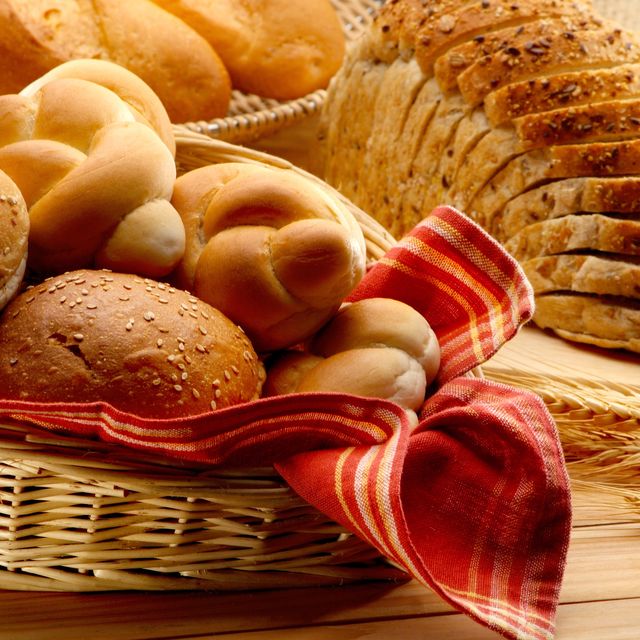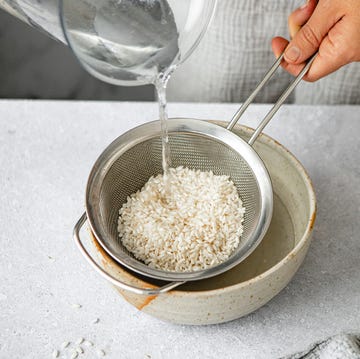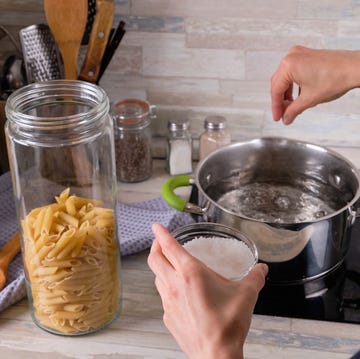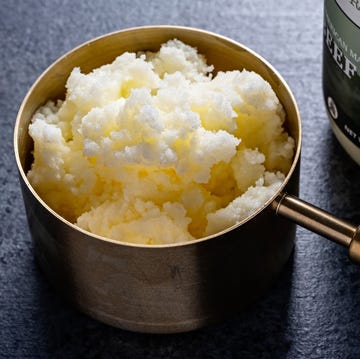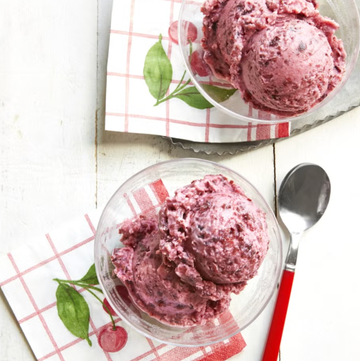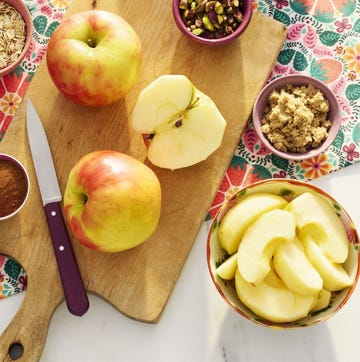1White Bread
 Somyot Techapuwapat//Getty Images
Somyot Techapuwapat//Getty ImagesThe granddaddy of all sandwich breads, white bread is practically an American icon—the bookends housing a lunchtime PB&J, the slice upon which butter is slathered, the mop for all the barbecue juices and sauce pooled beneath a meaty stack. White bread comes from white flour, which is the result of milling once the bran and germ are removed from the wheatberry. This process removes the natural oils found in wheatberries, which allows for a longer shelf-life, as it's the oils found in the bran and germ that go rancid first. This also means that white bread lacks the nutritional benefits found in breads using whole grains.
2Whole Wheat Bread
 Tetra Images//Getty Images
Tetra Images//Getty ImagesWhole wheat bread is made from flour that uses just that—the whole wheatberry. This means that whole wheat bread boasts more nutritional value, as the flour is milled from the whole grain, which boasts more fiber and protein than flours milled without the bran or germ. Whole wheat bread also has a deeper, richer flavor than white bread.
Advertisement - Continue Reading Below
3Multigrain Bread
 kajakiki//Getty Images
kajakiki//Getty ImagesTechnically, multigrain bread is made from at least two different grains—think oat, barley, millet, flax, etc. However, this doesn't mean whole grains are always used, so if seeking a nutritional boost from multigrain bread, be sure to check the label to ensure that whole grains were used and the the bread does in fact pack in more nutrients.
4Rye Bread
 Arx0nt//Getty Images
Arx0nt//Getty ImagesWithout the rye berry, there would be no rye bread—and without rye bread, there would be no Reuben sandwich. And if you've ever had a Reuben, you know that a world without this classic sandwich would be a travesty of epic proportions! Okay, okay... maybe that's stretching it, but rye bread is among a category of breads that should be deemed "unforgettable." There's a wide range when it comes to rye bread, as varying levels of color, texture and even flavor are dependent on the amount of rye flour used as well as which part of the grain is milled. Most sliced rye bread found in supermarkets also contains caraway seeds, which add another distinctive level of flavor. Crispbreads, a popular northern European snack resembling a crispy flatbread, are often made using rye flour.
Advertisement - Continue Reading Below
5Sourdough Bread
 janetleerhodes//Getty Images
janetleerhodes//Getty ImagesUnlike most leavened breads that include commercial yeast found in the baking aisle, sourdough is made from entirely wild yeast, which feeds and grows on a water-flour combination known as a "starter." Wild yeast requires more time for dough to rise, compared to commercial yeast, and the process results in the signature "sour" flavor beloved by sourdough-lovers everywhere. Essentially a white bread with a much more pronounced flavor, sourdough is known for having a crisp, crusty exterior and porous, fluffy interor.
6Pumpernickel Bread
 dlerick//Getty Images
dlerick//Getty ImagesTrue pumpernickel bread is a German variety of rye bread made using only rye flour and a long baking time set at a low temperature. However, some supermarket varieties of pumpernickel bread are made from a dough combination of rye flour and regular white flour that is then colored with molasses in order to achieve its signature brown color.
Advertisement - Continue Reading Below
7Baguette
 Galiya Assan / 500px//Getty Images
Galiya Assan / 500px//Getty ImagesIs there anything more French? Considering over 30 million baguettes are sold in France daily, there's a reason why the baguette also gets labeled "French bread" in some parts. These long, crusty loaves can range in length to upwards of two-and-a-half feet and are beloved for their crisp exteriors and soft, chewy interiors.
8Boule
 Food Style and Photography//Getty Images
Food Style and Photography//Getty ImagesThe French word for "ball," a boule is named after the shape the dough takes on before being baked. Some boules are made with a dough comprised of the same classic ingredients used to make a baguette, but others are made with blends of flours or even mix-ins like olives or fresh herbs.
Advertisement - Continue Reading Below
9Ciabatta
 shomos uddin//Getty Images
shomos uddin//Getty ImagesThis Italian loaf came about in 1982 as a response to the popularity of the French baguette. Made from a dough that includes olive oil, ciabatta is known for its porous interior featuring alveolar-like air pockets and was developed for the sole purpose of being a better match for classic Italian food than other existing breads. It's also used to make Italian sandwiches known as panini.
10Challah
 ishai01//Getty Images
ishai01//Getty ImagesA symbolic bread within the Jewish faith, challah is often braided into loaves and made from an egg-heavy dough, which gives the bread its signature yellow hue. It's soft, fluffy, and tender with occasional toppings like poppy seeds or salt that symbolize different religious meanings.
Advertisement - Continue Reading Below
11Brioche
 Mrs_2015//Getty Images
Mrs_2015//Getty ImagesThis sweet, fluffy bread is French in origin, but has become omnipresent in its use thanks to its fluffy, buttery consistency. It's a a rich dough made using both eggs and butter, which lends itself well to dishes like French toast and bread puddings.
12Flatbread
 Claudia Totir//Getty Images
Claudia Totir//Getty ImagesThe word "flatbread" will appear on some bread labels, but when it comes down it, flatbread is more of an over-arching type of bread that applies to multiple international options including—but not limited to!—naan, pita, tortillas, lavash, focaccia, roti and matzoh. Some are leavened, others are not, but they're all doughs that are rolled flat before being baked or cooked over a heat source.
Advertisement - Continue Reading Below
13English Muffin
 Lauri Patterson//Getty Images
Lauri Patterson//Getty ImagesA yeasted bread that's less like a muffin and more akin to an English crumpet, English muffins are known for their craggy interiors. The dough is cooked over a heat source on both sides, which gives them their signature browned exteriors.
14Bagel
 Ian Laker Photography//Getty Images
Ian Laker Photography//Getty ImagesAn icon of the Jewish delicatessen, bagels differ from standards breads for two reasons: They have a hole in the center and the dough is boiled before being baked, thus giving the bagel it's signature glossy exterior.
Advertisement - Continue Reading Below
15Bialy
 cislander//Getty Images
cislander//Getty ImagesBialys are the more rustic cousin of the bagel, as they're also a beloved staple of Jewish delicatessens. However, instead of the hole in the center, bialys have a depression instead that is filled with many of the same toppings that appear on bagels; the bialy is also baked straightaway from dough, skipping the boiling part that defines the bagel, and thus giving it more of a traditional bread-like exterior.
Advertisement - Continue Reading Below
Advertisement - Continue Reading Below
Advertisement - Continue Reading Below
